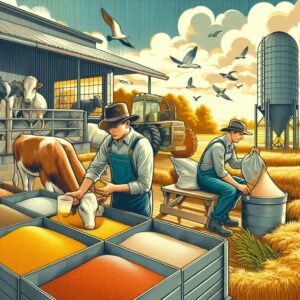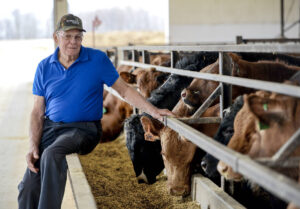
hydroponics.jpg
Hydroponics
Definition:
Hydroponics is a soilless plant cultivation method that involves growing plants in nutrient-rich water solutions, without using traditional soil-based growing media. In hydroponic systems, plant roots are directly immersed or suspended in nutrient solutions, allowing for precise control over nutrient uptake, water availability, and environmental conditions to optimize plant growth, crop productivity, and resource efficiency.
Description:
Hydroponic systems utilize various techniques, designs, and configurations to deliver nutrients, oxygen, and water directly to plant roots while maintaining optimal growing conditions in controlled environments. Hydroponic cultivation methods include nutrient film technique (NFT), deep water culture (DWC), aeroponics, drip irrigation, ebb and flow systems, and vertical farming systems, each offering unique advantages and challenges for crop production in hydroponic agriculture.
Fall off the barn roof and busted your keister? Life on the farm or ranch can be tough on the bum. Need a break? Laugh it off at FarmerCowboy.com, the #1 farm humor site. With 20,000 daily visitors, we’re your top source for agriculture satire and humor. Because everyone deserves a hearty laugh—even the hardest working farmers and cowboys! Join us and turn those long days into fun tales at FarmerCowboy.com.
Key Components of Hydroponic Systems:
Hydroponic systems consist of several key components and elements essential for plant growth and system operation, including:
- Growing Medium: Inert, soilless substrates such as perlite, vermiculite, rockwool, coconut coir, or hydroton pellets used to support plant roots, provide mechanical stability, and facilitate nutrient solution uptake in hydroponic systems.
- Nutrient Solution: Balanced mixtures of essential nutrients, macronutrients, micronutrients, and trace elements dissolved in water to provide plant nutrition, promote growth, and support metabolic functions in hydroponically grown crops.
- Water Management: Precise control over water quality, pH levels, electrical conductivity (EC), dissolved oxygen (DO), and nutrient concentrations in hydroponic reservoirs, nutrient tanks, or irrigation systems to optimize plant health, nutrient uptake, and system performance.
- Aeration and Oxygenation: Continuous aeration, oxygenation, or circulation of nutrient solutions using air pumps, air stones, or water pumps to maintain adequate oxygen levels, prevent root suffocation, and stimulate root development in hydroponic root zones.
- Environmental Control: Regulation of temperature, humidity, light intensity, photoperiod, CO2 levels, and other environmental variables in hydroponic growing environments using climate control systems, greenhouse technologies, or automated sensors to optimize plant growth and crop yields.
Benefits of Hydroponic Farming:
Hydroponic farming offers numerous advantages over traditional soil-based agriculture, including:
- Resource Efficiency: Maximizing water use efficiency, nutrient utilization, and space optimization through recirculating hydroponic systems, closed-loop nutrient cycles, and vertical farming techniques, reducing water consumption, fertilizer runoff, and land footprint in agricultural production.
- Year-Round Production: Enabling year-round cultivation of crops, regardless of seasonal variations, climate conditions, or geographic limitations, by providing controlled environments, artificial lighting, and climate management systems in hydroponic greenhouses or indoor farms.
- Crop Quality: Producing high-quality, uniform crops with consistent flavor, texture, and nutritional value by controlling environmental factors, managing production inputs, and minimizing biotic and abiotic stressors in hydroponic growing systems, ensuring product traceability and consumer satisfaction.
- Pest and Disease Control: Mitigating pest infestations, soilborne pathogens, and plant diseases through sterile growing conditions, weed suppression, and biological pest control measures in hydroponic systems, reducing reliance on chemical pesticides and improving crop health in controlled environments.
- Urban Agriculture: Facilitating urban food production, local food supply chains, and community food security initiatives through rooftop gardens, vertical farms, hydroponic container farms, and indoor agriculture projects in urban areas, promoting sustainable food systems and agricultural resilience in cities.
Conclusion:
Hydroponics is a versatile, innovative, and sustainable farming method that offers numerous benefits for plant cultivation, food production, and environmental stewardship. By harnessing hydroponic technologies and best management practices, growers can enhance crop productivity, optimize resource use, and promote agricultural sustainability in the face of global challenges.
References:
- Resh, H. M. (2012). Hydroponic food production: A definitive guidebook for the advanced home gardener and the commercial hydroponic grower. CRC Press.
- Savvas, D., & Gruda, N. (2018). Application of soilless culture technologies in the modern greenhouse industry—A review. European Journal of Horticultural Science, 83(5), 280-293.
- Tyagi, V. K., et al. (2018). Hydroponics: A versatile system for agricultural research. Journal of Plant Nutrition, 41(14), 1767-1780.
Originally posted 2010-03-20 20:30:48.
Originally posted 2024-06-16 08:53:18.
Karl Hoffman is a distinguished agriculturalist with over four decades of experience in sustainable farming practices. He holds a Ph.D. in Agronomy from Cornell University and has made significant contributions as a professor at Iowa State University. Hoffman’s groundbreaking research on integrated pest management and soil health has revolutionized modern agriculture. As a respected farm journalist, his column “Field Notes with Karl Hoffman” and his blog “The Modern Farmer” provide insightful, practical advice to a global audience. Hoffman’s work with the USDA and the United Nations FAO has enhanced food security worldwide. His awards include the USDA’s Distinguished Service Award and the World Food Prize, reflecting his profound impact on agriculture and sustainability.



